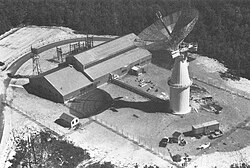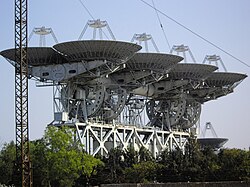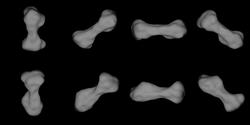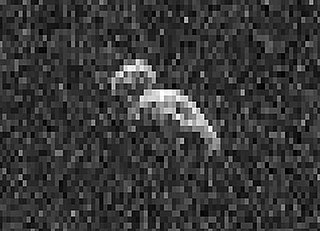
A near-Earth object (NEO) is any small Solar System body orbiting the Sun whose closest approach to the Sun (perihelion) is less than 1.3 times the Earth–Sun distance. This definition applies to the object's orbit around the Sun, rather than its current position, thus an object with such an orbit is considered an NEO even at times when it is far from making a close approach of Earth. If an NEO's orbit crosses the Earth's orbit, and the object is larger than 140 meters (460 ft) across, it is considered a potentially hazardous object (PHO). Most known PHOs and NEOs are asteroids, but about 0.35% are comets.
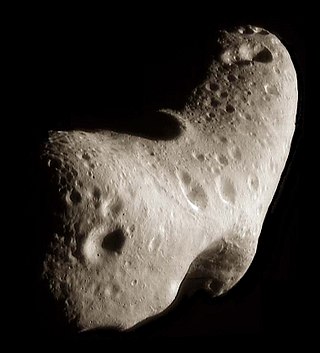
Eros is a stony asteroid of the Amor group, and the first discovered, and second-largest near-Earth object. It has an elongated shape and a volume-equivalent diameter of approximately 16.8 kilometers. Visited by the NEAR Shoemaker space probe in 1998, it became the first asteroid ever studied from its own orbit.

Steven Jeffrey Ostro was an American scientist specializing in radar astronomy. He worked at NASA's Jet Propulsion Laboratory. Ostro led radar observations of numerous asteroids, as well as the moons of Jupiter and Saturn, Saturn's rings, and Mars and its satellites. As of May 2008, Ostro and his collaborators had detected 222 near-Earth asteroids and 118 main belt objects with radar.
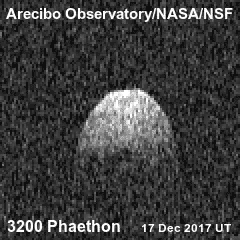
3200 Phaethon, provisionally designated 1983 TB, is an active Apollo asteroid with an orbit that brings it closer to the Sun than any other named asteroid. For this reason, it was named after the Greek myth of Phaëthon, son of the sun god Helios. It is 5.8 km (3.6 mi) in diameter and is the parent body of the Geminids meteor shower of mid-December. With an observation arc of 35+ years, it has a very well determined orbit. The 2017 Earth approach distance of about 10 million km was known with an accuracy of ±700 m.
99942 Apophis (provisional designation 2004 MN4) is a near-Earth asteroid and a potentially hazardous object with a diameter of 370 metres (1,210 feet) that caused a brief period of concern in December 2004 when initial observations indicated a probability up to 2.7% that it would hit Earth on April 13, 2029. Additional observations provided improved predictions that eliminated the possibility of an impact on Earth in 2029. Until 2006, a small possibility nevertheless remained that, during its 2029 close encounter with Earth, Apophis would pass through a gravitational keyhole of no more than about 800 kilometres (500 mi) in diameter, which would have set up a future impact exactly seven years later on April 13, 2036. This possibility kept it at Level 1 on the Torino impact hazard scale until August 2006, when the probability that Apophis would pass through the keyhole was determined to be very small and Apophis's rating on the Torino scale was lowered to zero. By 2008, the keyhole had been determined to be less than 1 km wide. During the short time when it had been of greatest concern, Apophis set the record for highest rating ever on the Torino scale, reaching level 4 on December 27, 2004.
Gordon Hemenway Pettengill was an American radio astronomer and planetary physicist. He was one of the first to take radar from its original military application to its use as a tool for astronomy. He was professor emeritus at the Massachusetts Institute of Technology.
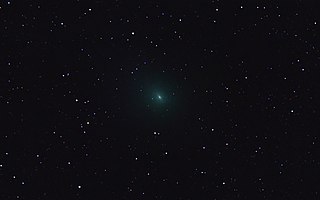
45P/Honda–Mrkos–Pajdušáková is a short-period comet discovered by Minoru Honda December 3, 1948. It is named after Minoru Honda, Antonín Mrkos, and Ľudmila Pajdušáková. The object revolves around the Sun on an elliptical orbit with a period of 5.25 years. The nucleus is 1.3 kilometers in diameter. On August 19 and 20, 2011, it became the fifteenth comet detected by ground radar telescope.

65803 Didymos is a sub-kilometer asteroid and binary system that is classified as a potentially hazardous asteroid and near-Earth object of the Apollo group. The asteroid was discovered in 1996 by the Spacewatch survey at Kitt Peak, and its small 160-meter minor-planet moon, named Dimorphos, was discovered in 2003. Due to its binary nature, the asteroid was then named Didymos, the Greek word for 'twin'.

Discovery and exploration of the Solar System is observation, visitation, and increase in knowledge and understanding of Earth's "cosmic neighborhood". This includes the Sun, Earth and the Moon, the major planets Mercury, Venus, Mars, Jupiter, Saturn, Uranus, and Neptune, their satellites, as well as smaller bodies including comets, asteroids, and dust.

101955 Bennu (provisional designation 1999 RQ36) is a carbonaceous asteroid in the Apollo group discovered by the LINEAR Project on 11 September 1999. It is a potentially hazardous object that is listed on the Sentry Risk Table and has the highest cumulative rating on the Palermo Technical Impact Hazard Scale. It has a cumulative 1-in-1,750 chance of impacting Earth between 2178 and 2290 with the greatest risk being on 24 September 2182. It is named after Bennu, the ancient Egyptian mythological bird associated with the Sun, creation, and rebirth.

(308635) 2005 YU55, provisionally named 2005 YU55, is a potentially hazardous asteroid 360±40 meters in diameter, as measured after its Earth flyby. Previously it was estimated to be 310 meters or about 400 m (1,300 feet) in diameter. It was discovered on 28 December 2005 by Robert S. McMillan at Steward Observatory, Kitt Peak. On 8 November 2011 it passed 0.85 lunar distances (324,900 kilometers; 201,900 miles) from Earth.
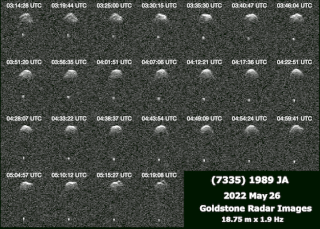
(7335) 1989 JA is a stony asteroid of the Apollo group, classified as near-Earth object and potentially hazardous asteroid, approximately 1 kilometer in diameter. It was discovered on 1 May 1989, by American astronomer Eleanor Helin at the U.S. Palomar Observatory in California. On 27 May 2022, the asteroid made a close approach 0.027 astronomical units from Earth. During the close approach, optical observations detected signs of an orbiting satellite, which was later confirmed by radar imaging at NASA's Goldstone Solar System Radar in California.

The Florida Space Institute (FSI) is a research institute of the State University System of Florida and the University of Central Florida located in Orlando, Florida, United States.
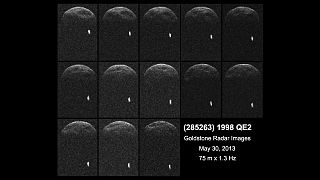
(285263) 1998 QE2, provisional designation 1998 QE2, is a dark asteroid and synchronous binary system, classified as near-Earth object and potentially hazardous asteroid of the Amor group, approximately 3 kilometers in diameter. It was discovered on 19 August 1998, by astronomers of the LINEAR program at Lincoln Laboratory's Experimental Test Site near Socorro, New Mexico, in the United States. Its sub-kilometer minor-planet moon was discovered by radar on 30 May 2013.

2015 TB145 is a sub-kilometer asteroid, classified as near-Earth object and potentially hazardous asteroid of the Apollo group, approximately 650 meters (2,000 feet) in diameter. It safely passed 1.27 lunar distances from Earth on 31 October 2015 at 17:01 UTC, and passed by Earth again in November 2018.

The Goldstone Solar System Radar (GSSR) is a large radar system used for investigating objects in the Solar System. Located in the desert near Barstow, California, it comprises a 500-kW X-band transmitter and a low-noise receiver on the 70-m DSS 14 antenna at the Goldstone Deep Space Communications Complex. It has been used to investigate Mercury, Venus, Mars, the asteroids, and moons of Jupiter and Saturn. The most comparable facility was the radar at Arecibo Observatory, until that facility collapsed. GSSR now stands alone.

2014 JO25 is a near-Earth asteroid. It was discovered in May 2014 by astronomers at the Catalina Sky Survey near Tucson, Arizona - a project of NASA's NEO (Near Earth Object) Observations Program in collaboration with the University of Arizona.

(163899) 2003 SD220 is a sub-kilometer asteroid and tumbling slow rotator, classified as near-Earth object and potentially hazardous asteroid of the Aten group, which orbit the Sun between Venus and Earth. Its orbital period of 0.75 years means that it orbits the Sun about 4 times for every 3 of the Earth. It was discovered on 29 September 2003, by astronomers of the Lowell Observatory Near-Earth-Object Search at Anderson Mesa Station near Flagstaff, Arizona.

2017 YE5 is a binary pair of asteroids of approximately equal size and mass, each about 0.9 km (0.56 mi) in diameter. Classified as a near-Earth asteroid and potentially hazardous object of the Apollo group, 2017 YE5 was discovered by amateur astronomer Claudine Rinner at the Oukaïmeden Observatory on 21 December 2017. On 21 June 2018, the pair of asteroids passed within 15.5 lunar distances or approximately 6 million km (3.7 million mi) from Earth. During the close encounter, 2017 YE5 was resolved in high detail by concurrent radar observations by the Arecibo and Green Bank observatories, along with individual observations by the Goldstone Solar System Radar. 2017 YE5 is likely an extinct or dormant comet due to its distant elliptical orbit and dark red surface.
